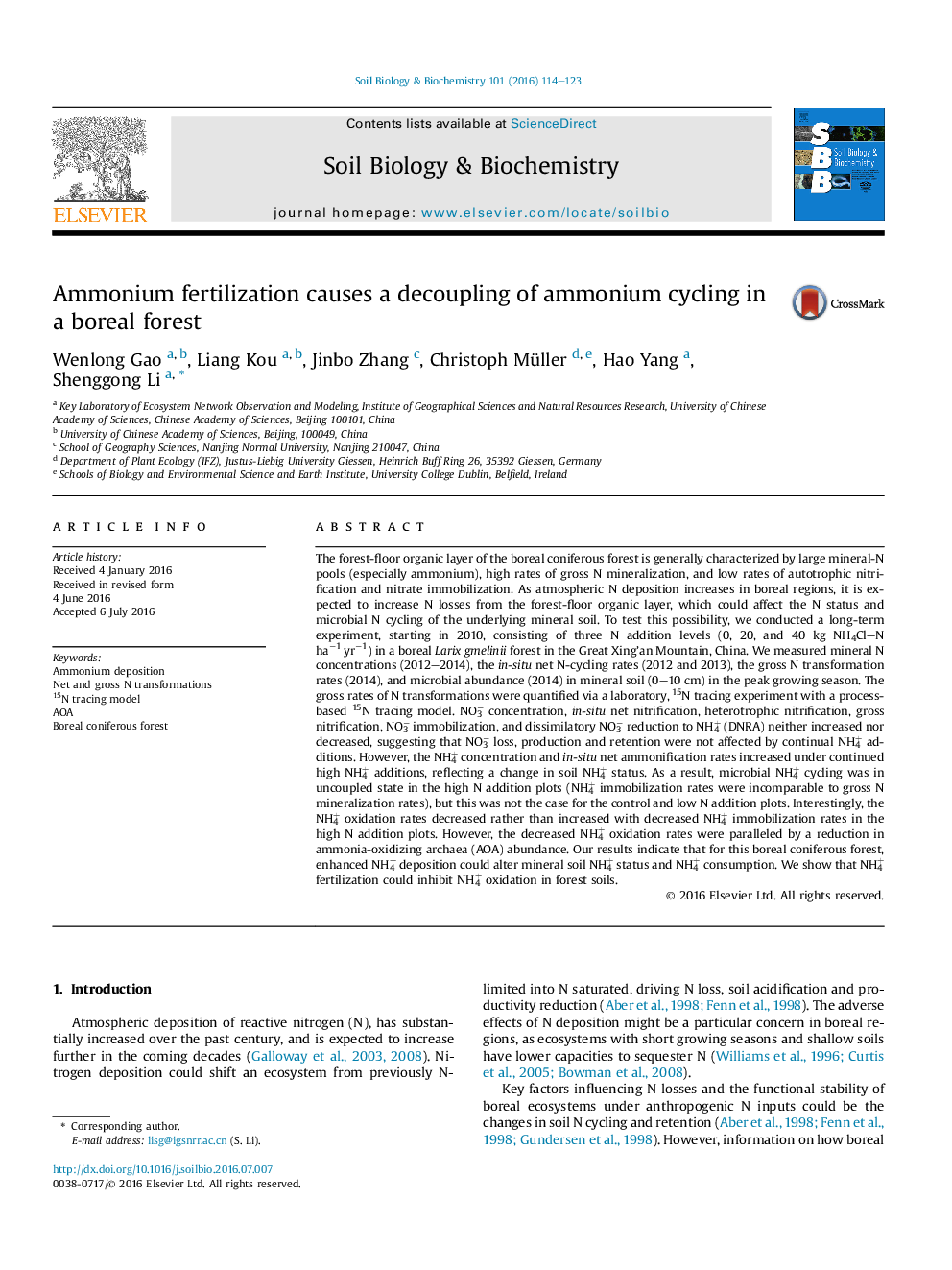| کد مقاله | کد نشریه | سال انتشار | مقاله انگلیسی | نسخه تمام متن |
|---|---|---|---|---|
| 8363430 | 1542583 | 2016 | 10 صفحه PDF | دانلود رایگان |
عنوان انگلیسی مقاله ISI
Ammonium fertilization causes a decoupling of ammonium cycling in a boreal forest
ترجمه فارسی عنوان
کوددهی آمونیوم باعث جدا شدن آمونیاک دوچرخه سواری در جنگلهای ساحلی می شود
دانلود مقاله + سفارش ترجمه
دانلود مقاله ISI انگلیسی
رایگان برای ایرانیان
موضوعات مرتبط
علوم زیستی و بیوفناوری
علوم کشاورزی و بیولوژیک
دانش خاک شناسی
چکیده انگلیسی
The forest-floor organic layer of the boreal coniferous forest is generally characterized by large mineral-N pools (especially ammonium), high rates of gross N mineralization, and low rates of autotrophic nitrification and nitrate immobilization. As atmospheric N deposition increases in boreal regions, it is expected to increase N losses from the forest-floor organic layer, which could affect the N status and microbial N cycling of the underlying mineral soil. To test this possibility, we conducted a long-term experiment, starting in 2010, consisting of three N addition levels (0, 20, and 40Â kg NH4ClN haâ1Â yrâ1) in a boreal Larix gmelinii forest in the Great Xing'an Mountain, China. We measured mineral N concentrations (2012-2014), the in-situ net N-cycling rates (2012 and 2013), the gross N transformation rates (2014), and microbial abundance (2014) in mineral soil (0-10Â cm) in the peak growing season. The gross rates of N transformations were quantified via a laboratory, 15N tracing experiment with a process-based 15N tracing model. NO3â concentration, in-situ net nitrification, heterotrophic nitrification, gross nitrification, NO3â immobilization, and dissimilatory NO3â reduction to NH4+ (DNRA) neither increased nor decreased, suggesting that NO3â loss, production and retention were not affected by continual NH4+ additions. However, the NH4+ concentration and in-situ net ammonification rates increased under continued high NH4+ additions, reflecting a change in soil NH4+ status. As a result, microbial NH4+ cycling was in uncoupled state in the high N addition plots (NH4+ immobilization rates were incomparable to gross N mineralization rates), but this was not the case for the control and low N addition plots. Interestingly, the NH4+ oxidation rates decreased rather than increased with decreased NH4+ immobilization rates in the high N addition plots. However, the decreased NH4+ oxidation rates were paralleled by a reduction in ammonia-oxidizing archaea (AOA) abundance. Our results indicate that for this boreal coniferous forest, enhanced NH4+ deposition could alter mineral soil NH4+ status and NH4+ consumption. We show that NH4+ fertilization could inhibit NH4+ oxidation in forest soils.
ناشر
Database: Elsevier - ScienceDirect (ساینس دایرکت)
Journal: Soil Biology and Biochemistry - Volume 101, October 2016, Pages 114-123
Journal: Soil Biology and Biochemistry - Volume 101, October 2016, Pages 114-123
نویسندگان
Wenlong Gao, Liang Kou, Jinbo Zhang, Christoph Müller, Hao Yang, Shenggong Li,
